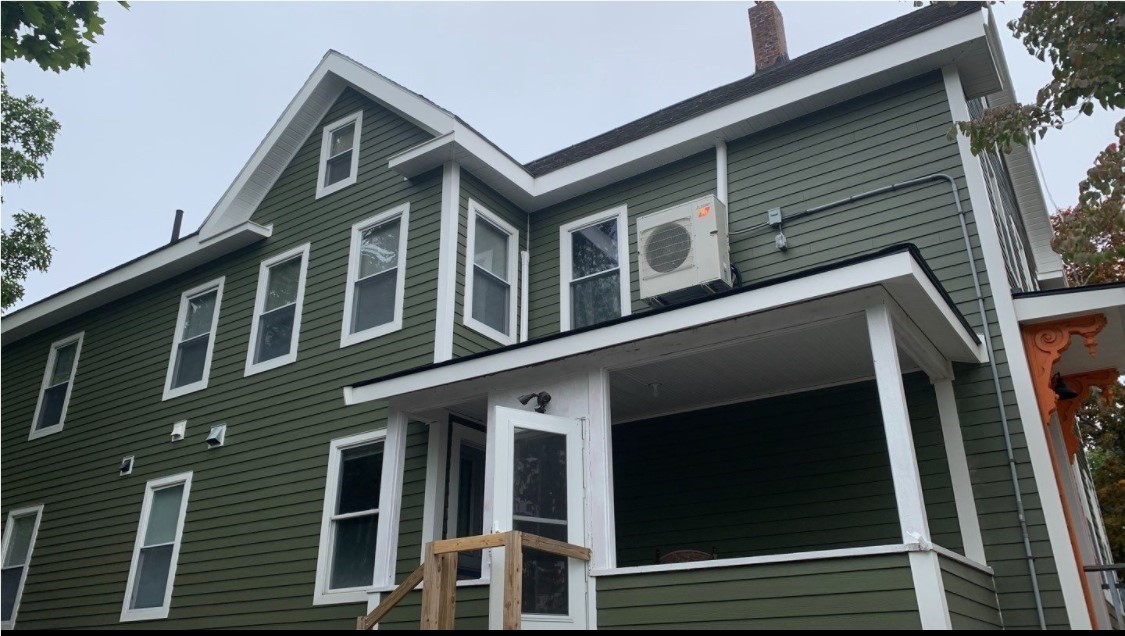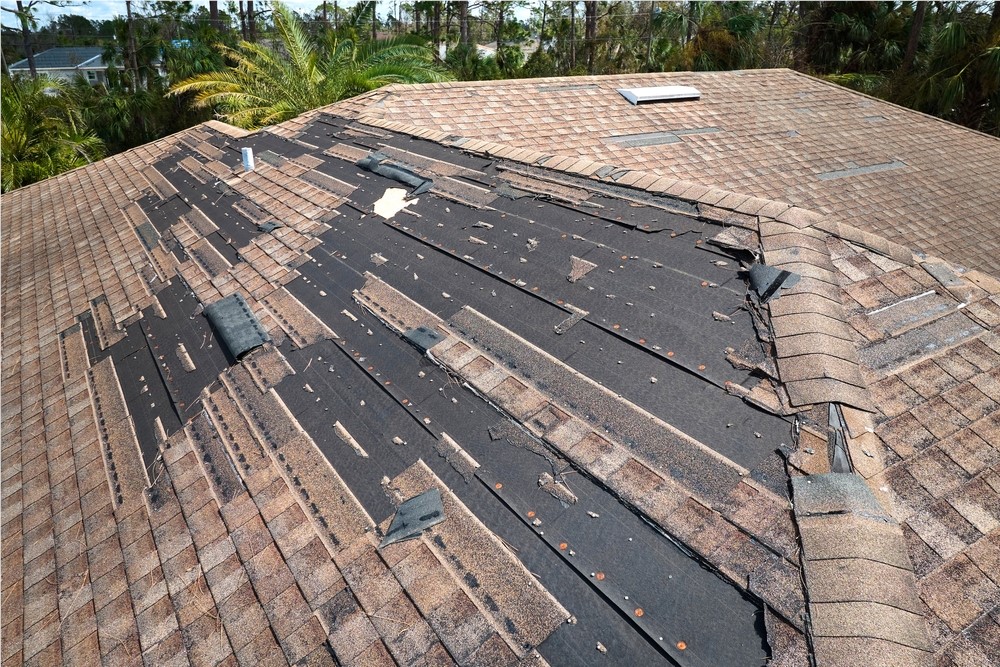Sometimes it is rather obvious that your roof is failing. When things are really bad, you’ll see leaks penetrating the ceilings and walls of your home. And when things are really really bad, you’ll see exposed rafters — don’t let things get really really bad.
Fortunately, when there’s a failure, there’s a fix, and here at Red Dog’s Roofing, we specialize in roofing services. Regardless of the material of your roof, we can repair or replace it. We work on rubber roofs, TPO roofing, PVC roofing, modified bitumen roofs, torch-down roofing, and other flat roof coatings. We also work on shingle roofs, wooden shake roofing, slate tile roofs (and composite tile roofs), and metal roofing. As we said, we do it all! So let’s talk damage. Below are some signs that your roof is failing — for your convenience, we’ve separated out the issues into two parts: sloped roof problems and flat roof problems. Sloped Roof Problems
Sloped Roof Problems
Sloped roofs can endure a different variety of issues than flat-roofed buildings. For instance, since the roof is sloped, the roofing material is more likely to succumb to gravity. Sloped roofs are also more exposed to wind, and a sloped roof with poor flashing and compromised roofing materials can actually hold moisture against the roofing structure. Leaks
A visible leak is the most obvious sign of roof damage. If you notice wet ceilings or walls throughout your house, locate the source. Try to get into the attic if possible. Check your attic for wet insulation and signs of a leak. You may even have a puddle on your attic floor if the problem is bad enough.Age
Roofs fail. While there are materials out there that are designed to last a century or more, age will catch up to even the best roofing materials. If you have a shingled roof, like most Americans do, you can expect your shingles to withstand the elements for 20 to 50 years, depending on the manufacturer, the material, and the climate. If you have slate or composite tile roofing, your roof might last more than 100 years. Metal is second best, lasting between 40 and 80 years, depending on the material and its protective coating (if it has one). Wooden shakes can last about 30 years.Bad or Missing Shingles & Tiles
Sagging Roof
Roofs can sag due to age, moisture penetration, and weight. If you have a roof that’s sitting under a few feet of snow, for instance, your roofing structure had better be strong enough to handle that weight. If you notice a sagging roof, it’s likely that extensive repairs are necessary. Consult a contractor to assess the damage to your roof. Do not attempt to walk on your roof, as it is liable to collapse if it is showing signs that the structure is compromised.Granules in Your Gutters
Asphalt shingles hold hundreds of granules which protect your roof from moisture. However, these granules can become dislodged over time, which damages your shingles, and once again, the sublayer of your roof may be exposed. Keep an eye on your gutters and downspouts. If you see an accumulation of granules, it might be time to replace your old shingles. If your current asphalt shingles have only lasted for 20 years or so, you may want to switch manufacturers, there are better products out there!Bad Flashing
Flashing is as likely to become damaged as your other roofing materials, and it’s often placed in locations that need protection the most. While metal flashing can last for decades on end, the anchor material and mortar can fail faster. Flashing is especially important in the nooks and crannies of your roof, such as where a roof valley meets your chimney. Without properly maintained flashing, water can collect in these areas and seep into your home. Make sure your flashing is properly installed and maintained.Light in the Attic
It’s rare that damage becomes this extensive, but if you see light penetrating through the ceiling of your attic, your roof isn’t anywhere near protective enough. You made need to replace the decking of your roof, the felt protective layer of your roof, and the roofing material itself.Flat Roof Problems
Flat roofs have their fair share of problems, just the same as sloped roofs. And unfortunately for flat roof structures, these roofs are more likely to fail since they often harness weight and water, instead of shedding any precipitation right away. Flat roof maintenance is important, since a repair can be far more costly than continual maintenance of the roofing envelope. Keep an eye out for these signs of flat roof damage:Leaks
Once again, leaks are obvious, and they’re likely the first sign that you’ll notice if you have a failing roof. Leaking flat roofs can damage ceiling tiles, infrastructure, and drywall. Keep an eye out for stains on your ceiling or running down the sides of walls, and if you do notice a leak, it’s time to inspect your roof to locate the source.Wear and Tear
Over time, flat roofs simply deteriorate. Even with the strongest flat roofing material, damage is inevitable.Pooling Water
While some pooling is inevitable (flat roofs are, after all, flat), too much pooling can wreak havoc on your roof. Be mindful of your flat roof when precipitation starts to fall. Water should be able to escape the roof via troughs, drains, and downspouts. Be extra cautious if your roof is enduring snow and hail. Snow can accumulate, adding tons of weight to your roofing structure. In addition, hail can damage roofing materials, penetrating their protective surface.Sagging Roofs
A sagging roof is bad news, since it means that the structure of your roof is compromised. Do not walk on a sagging roof. Bring in a professional roofer to inspect your roof and its substructure. Your roof may have been overburdened or leaking for some time, which can cause a failure in its structure.Bad Flashing
Flashing is as necessary with flat roofs as it is with sloped roofs. Flashing should be in place along any vertical elements and protrusions throughout the roof, and it should be integrated with the roofing material on the flat sections of the roof. If the flashing of your roof is damaged, or the connective material has failed, water can penetrate the envelope of your building. Your flashing is just as important as the rest of your roofing materials. Red Dog's Roof Repairs
Red Dog's Roof Repairs
Have you noticed some damage on your roof? Don’t let it go unrepaired. Moisture can seep into the structure of your home, causing thousands of dollars in damage. Keep an eye out for issues like those mentioned above, and if you have any concern that your roof isn’t up to snuff, give us a call. We’ll drop by to take a look. Once again, don’t attempt to turn a damaged roof into a do-it-yourself project, it is dangerous to work on damaged structures. Instead, call on Massachusetts' professional roofers here at Red Dog’s Roofing. We provide a suite of roofing services for folks throughout Fitchburg, Leominster, Gardner, Westminster, Lunenburg, Lancaster, Ashburnham, Princeton, and Sterling. Protect your home or building with Red Dog’s Roofing!
Tags
Subscribe to Red Dog's Roofing's Blog









Comments